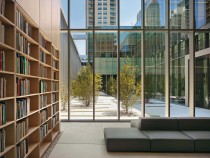
© Steve Hall / Hedrich Blessing Photographers
The Poetry Foundation is one of the world’s largest independent, non-profit literary organisations. Its new home is a building in dialogue with a garden. The garden space is created through erosion of an implied volume as described by the L-shaped property boundary of the site. In this manner, the garden is implied as another “room” and part of the building’s slowly unfolding spatial sequence. Visitors reach the building by walking through the garden, an approach that blurs hard distinctions between the public and private realms. Inside the building an exhibition gallery connects the library to the poetry reading room, where poets read their work to audiences in an intimate atmosphere, unmediated by technology. The architects employed a variety of materials – glass, concrete, fabric – to fine-tune the reading room’s acoustical qualities. Conceptually the building is made up of a series of layers through which visitors move. These layers – made of zinc, glass, and wood – peel apart to define the various programmatic zones. The outer layer, a cladding of corrugated oxidised zinc, lends the building a monolithic appearance from the outside. Where it borders the garden the cladding becomes perforated and takes on a veil-like, diaphanous quality, allowing visual access from the street. Where there are window openings it mutates into a sun-shading element. At the garden, the building enclosure terminates, but the zinc cladding continues over a series of aluminium-clad support members in a truss-like configuration.





